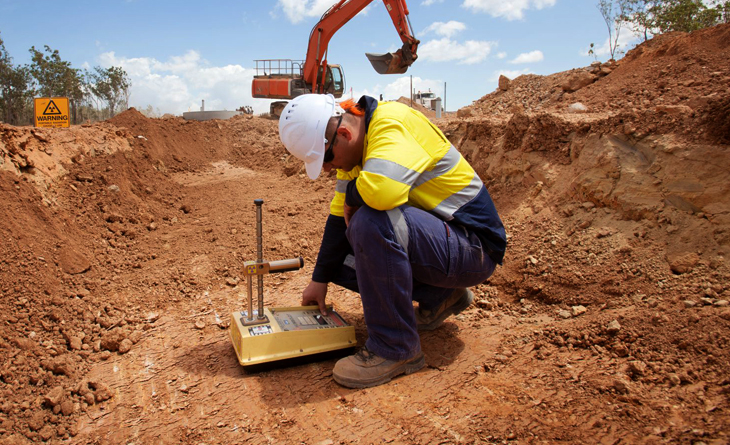
The construction of a building or a structure requires evident soil texting. The different types of soil testing methods depend on the properties of the soil. The foundation of the structure is based on the soil test report from the construction site. With the proper assessment of the soil, the building constructed is prone to collapsing at the least inconvenience.
But, What is Soil Testing?
Soil testing refers to the analysis of soil by commercial labs that conduct tests on the soil sample targeting certain minerals and compounds. Laboratories usually check for nutrients in 3 categories:
- Major nutrients: potassium (K), phosphorus (P), nitrogen (N)
- Secondary nutrients: magnesium, calcium, sulfur
- Minor nutrients: chlorine, molybdenum, boron, zinc, copper, manganese, iron
What are the Different Types of Soil Testing Methods?
1. Moisture Content Test
Water or moisture content is an important aspect of building construction. Amongst all the methods oven drying methods is the most commonly used method. Here are all the methods used to determine it:
- Alcohol method
A sample of soil is taken in an evaporating dry dish that has been weighed (W1) and noted.
The weight (W2) of the evaporating dish is again taken after the sample has been put into it.
Methylated spirit is poured over the soil sample at the rate of 1ml per gram of soil taken. With a palette knife, the methylated spirit is mixed into the soil well enough to have no hard lumps in it.
This mixture is then placed on a surface that is not affected by heat and ignited.
During this process, the soil is continuously stirred with a knife or a spatula.
When the methylated spirit is burnt away completely, the dish is cooled down and weighed (W3) again.
The percentage of water content is calculated as,
W = (W2-W3) / (W3-W1) * 100
- Radiation method
Radioactive isotopes are used to determine the quantity of water present in the soil.
The hydrogen atoms present in the soil’s water scatter the neutrons of the radioactive material and they hit the hydrogen atoms, resulting in a loss of energy.
The quantity of water in the soil is proportional to the loss of energy.
A detector is used to calibrate the water content.
The radioactive isotopes are placed in a device placed in steel casing which is then bored into the soil.
The detector used to detect the water content is placed in another steel casing across from the first steel casing.
- Sand bath method
The soil sample is crumpled and taken along with some pieces of white paper in a tray and placed in a sand bath which is then heated for about 20 to 60 mins.
Before heating, the sample tray is weighed.
It is made sure that the soil is not overheated. The pieces of paper turn brown the sandbath begins to overheat.
The drying process continues till the sample attains a constant mass after which the tray with the sample is cooled and weighed.
- Pycnometer method
A pycnometer is a jar made of glass fitted with a conical brass cap. There is a fiber washer or a rubber washer between the jar and the cap to prevent leakage.
A wet soil sample is taken in the pycnometer and weighed and noted. Then, the pycnometer is added to the soil sample to make it half full and mixed with a glass rod.
Then after making sure that there is no entrapped air in it, more water is added to the conical cap and stirred again.
The pycnometer is wiped, weighed, noted, and emptied.
Again, it is filled with water and wiped, weighed, and noted.
An equation is used to calculate the water content:
W = (M2-M1) / (M3-M4) * {[(G-1) / G] – 1} *100
Where,
M4 = mass of water-filled pycnometer
M3 = mass of water + wet soil + pycnometer
M2 = mass of wet soil + pycnometer
M1 = mass of pycnometer
- Torsion balance method
The soil sample is placed on the infrared lamp evenly.
A drum scale gives the percentage of the moisture content.
The wet weight of the soil is obtained by the ratio of the water weight read from the drum scale to the total weight.
Here, the total weight is the sum of the dry weight of the soil and the wet weight of the oil.
- Calcium carbide method
The wet soil sample is put in a sealed container with calcium carbide.
The reaction of water and calcium carbide results in acetylene gas. The pressure of the gas produced is shown on a pressure gauge.
The water content of the soil is calculated from the total mass shown on the gauge.
- Oven drying method
The soil sample is taken in an air-tight container and weighed separately.
Then the container with the sample is dried in an oven at a temperature of 110° +/- 5℃ for 24 hours to evaporate the water content in the sample.
The moisture content of the soil sample is calculated by,
W = (M2-M3) / (M3-M1)
Where,
M3 = mass of container with dry soil and lid
M2 = mass of the container with wet soil and lid
M1 = mass of the container with its lid
2. Atterberg Limits Tests
- Liquid limit test
Liquid limit is the moisture content at which a groove formed in the soil sample closes for 10mm when 25 blows are given to it.
Casagrande’s liquid limit device is filled with some soil samples.
A groove is created in the middle and the cup is moved up and down till the groove closes at some point.
The number of blows needed to close the groove is noted down.
Take a portion of the soil to measure the moisture content.
Repeat the test with several moisture contents 4 times with blows between 10 and 40.
A graph between the number of blows and water content is plotted and the water content corresponding to 25 blows represents the liquid limit.
- Plastic limit test
Add some water to the soil sample and roll it into a small ball.
After leaving it for some time, place the ball on a glass plate and roll it into 3mm diameter threads.
If the threads fail to break when rolled below 3mm diameter then the water content is more than the plastic limit.
The procedure is repeated till the threads crumble at 3mm diameter.
The water content of the resultant soil is the plastic limit.
- Shrinkage limit test
The water content needed to fill the voids of the soil is the shrinkage limit. The shrinkage limit is determined by the following equation,
Ws = [(M1-M2)n – (V1-V2)Pw] / M2
Where,
Pw = density of water
M2 = dry mass
V2 = volume of drying
M1 = initial mass
V1 = initial volume
3. Specific Gravity of Soil
- Density bottle method
A density bottle of 50ml is cleaned and dried at 105℃ to 110℃ and cooled. The mass (M1) is noted down.
Some dried soil sample is taken in the density bottle and weighed (M2).
Distilled water is added to the soil sample and soaked for 2 hours. Water is added till the bottle is half full and entrapped air is removed by vacuum pressure or heating.
Then the bottle is filled up to the brim and covered by a stopper. Its mass (M3) and temperature are noted.
The density bottle is emptied, washed, and filled with distilled water and its mass (M4) is noted.
G = Ms / (Ms+M4-M3)
Where,
Ms = mass of solids
- Measuring flask method
This soil testing method is similar to the dry density bottle method. Here, a measuring flask of 250ml or 500ml is fitted with an adaptor to connect the vacuum line so that there is no entrapped air. The soil sample must be oven-dried.
- Shrinkage limit method
A shrinkage limit can be defined as the least amount of water in saturated soil. In other words, the shrinkage limit is the maximum amount of water in the soil at which the further reduction of water will not decrease the volume of soil mass.
A shrinkage dish is placed inside a porcelain evaporating dish that contains mercury.
The insides of the shrinkage dish are coated with silicon grease or vaseline.
The soil sample is placed inside it and tapped firmly to remove entrapped air. More soil is added with simultaneous tapping till the dish is filled.
The soil is allowed to dry till the soil color turns light and then is dried in the oven.
A cup is filled with mercury and the dry pat of soil from the shrinkage dish is placed on this cup.
The excess mercury displaced is transferred to a mercury weighing dish and weighed.
Shrinkage Limit
Ws = [(M1-Ms) – (V1-V2) Pw] / Ms
Where,
Pw = density of water
Ms = mass of dry soil
V2 = total volume
V1 = volume of soil
M1 = mass of shrinkage dish with soil
Vd = volume of dry pat
- Pycnometer method
The specific gravity of soil can be calculated using this equation:
G = (M2-M1) / [(M2-M1) – (M3-M4)]
Where,
M4 = mass of pycnometer filled with distilled water only
M3 = mass of pycnometer, water, and soil
M2 = mass of pycnometer with dry soil
M1 = mass of empty pycnometer
- Glass jar method
This soil testing method is similar to the pycnometer method of soil testing but instead of a pycnometer, a 1-liter glass jar is used which is fitted with a rubber bung.
4. Dry Density Test
The dry density of soil is the weight of soil in a given volume of soil sample. It depends on the specific gravity of soil as well as its void ratio. Here are its 2 methods of soil testing:
- Core Cutter Method
The soil is cut from the ground using a cylindrical core cutter and weighed.
To calculate the dry density (Yd) of soil, the equation used is,
Yd = (100 * Yb) / (100 + W)
Yb = bulk density = (Ws – Wc) / Vc
W = water/moisture content of soil = (M/100 – M) * 100
Where,
M = mass
Vc = volume of core cutter
Wc = weight of soil + weight of core cutter
Ws = weight of the core cutter
- Sand Replacement Method
To find the dry density of a particular soil, a hole is excavated in it and filled with the soil with known dry density.
To get the volume of the hole, the mass of sand poured into the hole is divided by the dry density of the soil.
5. Compaction Test or Proctor’s Test
Compaction of soil is the reduction of air voids in the soil via densification and is measured in terms of the dry density of the soil.
- The soil sample is sieved and the percentage of soil sample passing through 4.75mm and retained at 4.75mm.
- Water is added to it and left in an airtight container for 20 hours.
- The soil sample is divided into some parts and each part of the sample is poured into the mold in 3 layers with 25 blows of ramming.
- The soil mold is weighed and noted.
- The soil is removed from the mold and the water content of small portions of the soil sample is taken.
- Now, the dry density of the soil is calculated.
- A graph is drawn between the dry density and the water content and the optimum values of both these parameters are noted.
The Bottom Line: Different Types of Soil Testing Methods
Soil testing methods are quite a scientific process done by laboratories. Some soil tests can also be done on the field. A building’s foundation is designed by the results of a soil test of the region. This exhaustive article on the different types of soil testing methods has all the step-by-step instructions on how to perform each of those tests. An improper soil test could lead to the collapse or damage of the structure.
Soil Testing FAQs:
1. What is the dry density of soil?
The dry density of soil is defined as the weight of soil particles in a particular volume of soil sample. The dry density of soil depends on the specific gravity and void ratio of soil. The soil is categorized into loose, medium dense, and dense depending on the values of dry density of soil. It is calculated by the water-displacement method, core cutter method, and sand replacement method.
2. How do you find the moisture content of soil?
The water or moisture content of the soil is a crucial aspect of construction. The most commonly used method for determining the moisture content of the soil is the oven drying method where the soil sample is weighed and dried in the oven at a temperature of 110 degrees C.
After 24 hours, the sample is taken and weighed again. Both the weighted values are noted and their difference is taken as the moisture or water content value of the soil. There are other methods of determining the moisture content of soil too such as:
3. What is the main purpose of soil testing?
Soil testing can define the expected growth potential or fertility of the soil. It can indicate the inhibitions from the presence of non-essential trace minerals, potential toxicities from excessive fertility, and nutrient deficiencies. The soil test mimics the function of roots to assimilate the minerals.






